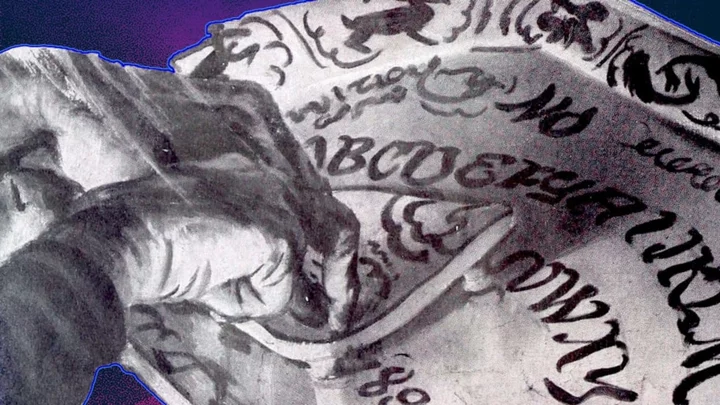The 19th century saw an explosion of interest in ghosts, and séances were all the rage. When the famous Fox sisters of Hydesville, New York, claimed in 1848 that they could speak to spirits that communicated by knocking on a table, the fad really took off—and more mediums came forward to manifest ectoplasm, bring messages from beyond the grave, and make objects fly mysteriously through the air.
The possibilities presented by the existence of a spiritual realm inspired the growth of spiritualism, which gripped the United States and the United Kingdom in the mid- to late-19th century. Intellectuals of the day began to take an interest in the paranormal. Some embraced psychical research, while others remained skeptical and tried to debunk the sensational stories. Here are eight 19th-century scientists who investigated ghosts.
1. Michael Faraday
In the 1850s, table turning became a popular pursuit after the humble table became the preferred conduit for conversing with spirits beyond the veil. Scientist Michael Faraday, best known for his discoveries of the laws of electrolysis and electromagnetic induction, took an interest in the science behind table turning in 1853, keen to investigate if the phenomenon could have an electrical or magnetic cause.
After conducting experiments into table turning by secretly monitoring the muscle movements of participants during a séance, Faraday published his conclusions in the Times newspaper on June 30, 1853. He concluded that that table turning wasn’t a spiritual phenomenon, but a physical one—and that participants were unconsciously moving the table themselves but were unaware they were doing so. Without fully understanding the mechanism behind the unconscious force, Faraday had stumbled upon the ideomotor effect.
2. William Benjamin Carpenter
Physiologist William Carpenter suggested the ideomotor response could explain how unconscious bodily actions may be responsible for the perceived motion of spiritualist tools like dowsing rods, pendulums, and Ouija boards. (He coined the word ideomotor in a 1852 paper.) Carpenter argued that Ouija boards, rather than providing spirits with a method to communicate with the living, demonstrated that any messages “received” were caused by the subconscious movements of the participants. Carpenter’s theory became highly influential in the field of psychical research because it offered a rational, scientific explanation for a variety of supernatural spectacles.
3. Alfred Russel Wallace
Naturalist Alfred Russel Wallace came up with the theory of evolution by natural selection independently of Charles Darwin. The two corresponded on the subject before Darwin scooped him by publishing On the Origin of Species in 1859. Wallace never gained the plaudits that Darwin enjoyed, and his contribution to the history of science was overshadowed by what many contemporaries saw as his ill-advised interest in spiritualism.
Wallace took the theory of evolution to another level by suggesting that it pointed to the existence of a supernatural realm. He believed that, unlike animals that evolved through natural selection, humans must be different because they had developed the ability to speak, make music, and do complex mathematics. Despite the ridicule he endured, Wallace continued to enthusiastically support spiritualist inquiry; he wrote numerous articles in defense of the continued existence of the human spirit after death and advocated for the authenticity of spirit photographs.
4. Pierre and Marie Curie
Nobel Prize-winning physicists Pierre and Marie Curie gained accolades for their discoveries of the radioactive elements radium and polonium—and it was their investigations into these seemingly invisible physical forces that gave them an interest in other unexplained phenomena. In 1905, the pair and some fellow scientists took part in a number of séances with the celebrated spiritual medium Eusapia Palladino. The medium produced several supernatural happenings during the séances, including strange noises, levitating tables, and flying objects. The assembled investigators struggled to debunk everything that had occurred, and Pierre especially felt sure that “the phenomena that we saw appeared inexplicable as trickery.”
Marie did not publicly support the concept of spiritualism, but after Pierre’s sudden death in a carriage accident at the age of 46, she began writing to him in her diary. Her unsendable letters suggest that, on some level, she believed in the ability to communicate with loved ones in the afterlife.
5. William James
William James (brother of novelist Henry and writer Alice James) laid the foundations of American psychology and was one of the founding members of the American Society for Psychical Research in 1885. The ASPR was an attempt to apply rigorous scientific standards to the investigation and exploration of the psychic realm, including telepathy, mediumship, and ghosts. James wrote excitedly to his cousin Kitty Prince that “ghosts, second sight, spiritualism, & all sorts of hobgoblins are going to be ‘investigated’ by the most high toned & ‘cultured’ members of the community.”
James accepted that many mediums were fraudulent, but he refused to believe this meant that all should be dismissed. He placed his faith in one psychic in particular, Leona Piper of Boston, after she appeared to bring him a message from his recently deceased infant son.
6. John Ferriar
In the early 19th century, physician and public health reformer John Ferriar made efforts to discover if ghosts were truly supernatural or if they had a more prosaic explanation. He published his findings as “An Essay Towards a Theory of Apparitions” in 1813.
“The forms of dead, or absent persons have been seen, and their voices have been heard, by witnesses whose testimony is entitled to belief,” he wrote. He pondered how sane people could believe they had seen or heard a ghost, and concluded that ghosts were in fact the result of “waking dreams composed of the shreds and patches of past sensations.” Ferriar argued that apparitions could be created by over-excited minds through mental projection, making ghosts a psychological phenomenon rather than a supernatural one.
7. Eleanor Sidgwick
Eleanor “Nora” Sidgwick was a mathematician, suffragist, and principal of Newnham College of the University of Cambridge. She became a key member of the Society for Psychical Research and later served as its president. Like its American counterpart co-founded by William James, the Society for Psychical Research was one of the most respected organizations exploring supernatural phenomena and included scientists, academics, and notable people among its members, such as Arthur Conan Doyle, chemist William Crookes, and physicist Oliver Lodge.
Sidgwick undertook a great deal of research for the SPR, looking into telepathy, mediums, and levitation. Her findings were mostly skeptical, though she believed that telepathy was a genuine but rare natural phenomenon. In 1891, fellow SPR member Alfred Russel Wallace asked the society to investigate spirit photography because he believed that many existing portraits purporting to show the inexplicable appearance of ghosts were genuine. Sidgwick took up the task and published a paper, “On Spirit Photographs,” which essentially debunked it and revealed many of the tricks used to create the ghostly effects.
8. William Fletcher Barrett
William F. Barrett was a noted physicist and Fellow of the Royal Society, but today he’s best remembered for his research into the paranormal. Barrett was at the forefront of the burgeoning field of psychical investigation, co-founding both the UK’s Society for Psychical Research and the American Society for Psychical Research.
Barrett was especially interested in spiritualism, poltergeists, and deathbed visions of dead people, believing that these phenomena could indicate the existence of life after death. He argued that measurable phenomena such as sounds waves and radiation could potentially provide clues to how spirits persisted. Barrett’s credulous position, however, placed him at odds with many fellow scientists and members of SPR, who were far more skeptical and concerned about maintaining scientific rigor. After he was criticized for failing to notice the simple conjuring tricks employed by certain mediums, Barrett turned his attention away from ghosts.
This article was originally published on www.mentalfloss.com as 8 Victorian Scientists Who Investigated Ghosts.









